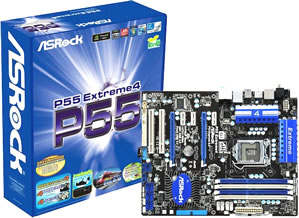BIOS & Overclocking
The BIOS configuration of the P55 Extreme4 is fairly traditional but Asrock has added a few of their own personal touches to help make it a little more functional. The first main menu gives users a quick look at the system specifications, including BIOS version, processor type, and various other things.
The next menu titled "OC Tweaker" is what we are most interested in. This is where almost all the system fine-tuning and overclocking action takes place. The first setting within this menu is designed for overclocking novices that want to get a little more out of their system with little trouble and at no extra cost. Dubbed "CPU EZ OC," this allows users to overclock their processor to a predefined setting at the click of a button.
With our Core i5 750 processor installed we could select a frequency ranging from 3.60GHz through to 4.20GHz in 100MHz increments. Unfortunately, while we have had success with this feature on previous Asrock motherboards that wasn't the case with the P55 Extreme4. We were only able to use the lowest clock setting (3.60GHz) whereas in the past the automatic overclocking feature has hit a stable 4.0GHz.
Because we received this motherboard with an early BIOS revision from Asrock we promptly updated to the latest version available at the time of testing (P1.10) but that didn't fix the issue. Since we last tested this motherboard two newer BIOS revisions have been released (latest revision just went out last week). We haven't got a chance to retest overclocking but the release notes are very scarce and don't mention anything about fixing overclocking stability.
Having failed to successfully overclock the P55 Extreme4 using the CPU EZ OC feature we decided to try and manually tweak the Core i5 750. To our disappointment, using a base clock of 175MHz with the Turbo 21x clock multiplier and 1.450v of power we arrived at a low overclock of just 3.67GHz.
In previous tests the worst performing Intel P55 motherboard in terms of overclocking abilities was the ECS P55H-A. which reached 3.80GHz. That's considerably better than what we were able to achieve with the Asrock P55 Extreme4. The original Asrock P55 Extreme also had no problem reaching 4.18GHz when we played with it last year. Given that both boards are very much the same we expect Asrock to address this issue eventually (if not already) with an updated BIOS revision.
Using the next option, titled "Memory EZ OC," we were able to boost the memory to 1600MHz using the best possible timings for our modules. It's worth mentioning that if you use this option it will change some of the settings configured by CPU EZ OC and in all instances we found that it lowered our overclock, so unfortunately it doesn't look like these two settings can be used simultaneously.
For the more capable overclocker ignoring the EZ OC options is probably the route to go as it allows for even finer tuning of the selected hardware. The P55 Extreme4 caters to the expert overclocker just as well as it does to the novice with a massive range of tweakable settings. Unfortunately, for now putting them to good use proved difficult.
We like how the EZ OC options have been tied in with the rest of the OC Tweaker menu. For example, if you wish to fine-tune whatever settings you get using CPU EZ OC overclock you can do that. Simply choose the frequency that you desire and then scroll down to the more technical settings and modify the values as you see fit.
